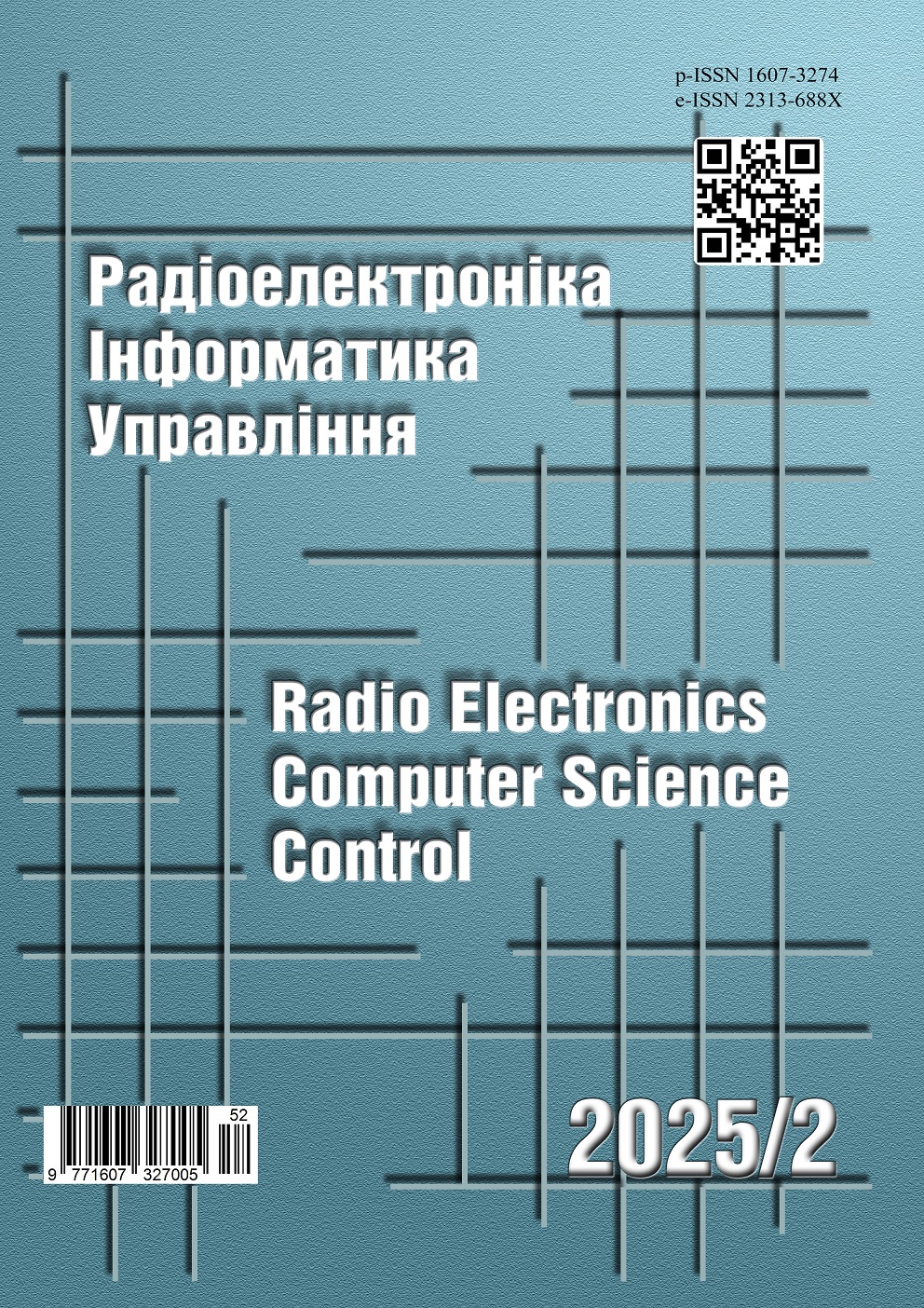SYNTHESIS OF NEURAL NETWORK MODELS FOR TECHNICAL DIAGNOSTICS OF NONLINEAR SYSTEMS
DOI:
https://doi.org/10.15588/1607-3274-2025-2-11Keywords:
technical diagnostics, nonlinear systems, machine learning, neural network synthesis, indicator system, neuromodel, sampling, learning, errorAbstract
Context. The problem of synthesizing a diagnostic model of complex technical processes in nonlinear systems, which should be characterized by a high level of accuracy, is considered. The object of research is the process of synthesizing a neural network model for technical diagnostics of nonlinear systems.
Objective of the work is to synthesize a high-precision neural network model based on previously accumulated historical data about the system.
Method. It is proposed to use artificial neural networks for modeling nonlinear technical systems. First, you need to perform an overall assessment of the complexity of the task. Based on the assessment, a decision can be made on the best approach to organizing neuromodel synthesis. So, for the task, the level of ‘random complexity’ was chosen, because despite the relative structure of the data, their total array is quite large in volume and requires careful study in order to ensure high quality of the solution. Therefore, in the future, it was proposed to use a neuromodel based on recurrent networks of the GRU topology and use swarm intelligence methods for neurosynthesis, in particular the A3C method. The results obtained showed a high level of solution obtained, but due to the high level of resource intensity, the proposed approach requires further modifications.
Results. A diagnostic model of complex technical processes in nonlinear systems of optimal topology, characterized by a high level of accuracy, is obtained. The built neuromodel reduces the risks associated with ensuring human safety.
Conclusions. The conducted experiments confirmed the operability of the proposed approach and allow us to recommend it for further refinement in order to implement technical, industrial and operational process control systems in practice in automation systems. Prospects for further research may lie in optimizing the resource intensity of synthesis processes
References
Ameisen E. Building Machine Learning Powered Applications, Going from Idea to Product. California, O’Reilly Media, 2020, 260 p.
Bonaccorso G. Mastering Machine Learning Algorithms, Expert techniques to implement popular machine learning algorithms and fine-tune your models. Birmingham, Packt Publishing, 2018, 576 p.
Patan K. Artificial Neural Networks for the Modelling and Fault Diagnosis of Technical Process. Berlin, Springer, 2008, 112 p. DOI: 10.1007/978-3-540-79872-9
Leoshchenko S., Oliinyk A., Subbotin S., Zaiko T. Using Modern Architectures of Recurrent Neural Networks for Technical Diagnosis of Complex Systems, 2018 International Scientific-Practical Conference Problems of Info-communications. Science and Technology (PIC S&T), Kharkiv, 9–12 October 2018, proceedings. Kharkiv, IEEE, 2018, pp. 411–416. DOI: 10.1109/INFOCOMMST.2018.8632015
Leoshchenko S., Subbotin S., Oliinyk A., Narivs’kiy O. Implementation of the indicator system in modeling complex technical systems. Radio Electronics, Computer Science, Control, 2021, Vol. 1, pp. 117–126. DOI: 10.15588/1607-3274-2021-1-12
Learning Phrase Representations using RNN Encoder-Decoder for Statistical Machine Translation, URL: https://arxiv.org/abs/1406.1078
Ahmadian A., Salahshour S. Soft Computing Approach for Mathematical Modeling of Engineering. London, Chapman and Hall (CRC Press), 2021, 222 p.
Sayyaadi H. Modeling, Assessment, and Optimization of Energy Systems. Cambridge, Academic Press, 2020, 558 p.
Koulamas C., Lazarescu M.T. Real-Time Sensor Networks and Systems for the Industrial IoT. Basel, Mdpi AG, 2020, 242 p. DOI: 10.3390/books978-3-03943-431-2
Senge P. M. The Fifth Discipline, The Art & Practice of The Learning Organization. New York, Doubleday, 2006, 445 p.
Bruce P., Bruce A. Practical Statistics for Data Scientists, 50 Essential Concepts. California, O’Reilly Media, 2017, 318 p.
Finch W.H. Exploratory Factor Analysis. California, SAGE Publications, 2019, 144 p.
Rencher A. C., Christensen W. F. Methods of Multivariate Analysis. New Jersey, John Wiley & Sons, 2012, 800 p.
Dean A., Voss D., Draguljić D. Design and Analysis of Experiments (Springer Texts in Statistics), 2nd Edition. Berlin, Springer, 2017, 865 p. DOI: 10.1007/978-3-319-52250-0
Sewak M. Deep Reinforcement Learning, Frontiers of Artificial Intelligence. Berlin, Springer, 2020, 220 p. DOI: 10.1007/978-981-13-8285-7
Leoshchenko S., Oliinyk A., Subbotin S., Lytvyn V., V. Shkarupylo V. Modification and parallelization of genetic algorithm for synthesis of artificial neural networks. Radio Electronics, Computer Science, Control, 2019, Vol. 4, pp. 68–82. DOI: 10.15588/1607-3274-2019-4-7.
Downloads
Published
How to Cite
Issue
Section
License
Copyright (c) 2025 S. D. Leoshchenko, A. O. Oliinyk, S. A. Subbotin, B. V. Morklyanyk

This work is licensed under a Creative Commons Attribution-ShareAlike 4.0 International License.
Creative Commons Licensing Notifications in the Copyright Notices
The journal allows the authors to hold the copyright without restrictions and to retain publishing rights without restrictions.
The journal allows readers to read, download, copy, distribute, print, search, or link to the full texts of its articles.
The journal allows to reuse and remixing of its content, in accordance with a Creative Commons license СС BY -SA.
Authors who publish with this journal agree to the following terms:
-
Authors retain copyright and grant the journal right of first publication with the work simultaneously licensed under a Creative Commons Attribution License CC BY-SA that allows others to share the work with an acknowledgement of the work's authorship and initial publication in this journal.
-
Authors are able to enter into separate, additional contractual arrangements for the non-exclusive distribution of the journal's published version of the work (e.g., post it to an institutional repository or publish it in a book), with an acknowledgement of its initial publication in this journal.
-
Authors are permitted and encouraged to post their work online (e.g., in institutional repositories or on their website) as it can lead to productive exchanges, as well as earlier and greater citation of published work.






